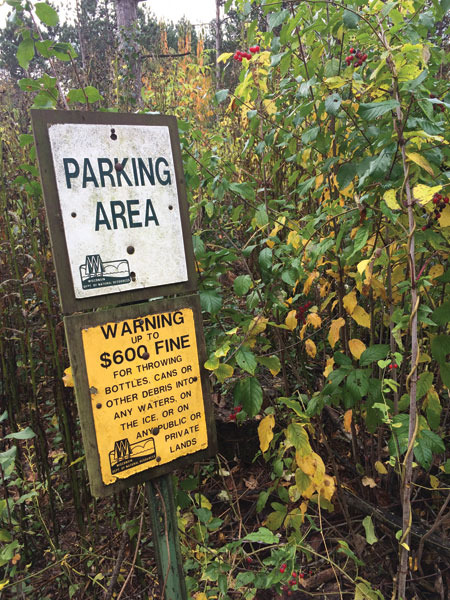Smart, low-impact access to hunting stands is equally important on private and public hunting land, as keeping deer unaware of your presence is a key part of success. On public land, you’re also competing with other hunters and land users for the best spots, and want to keep them from knowing exactly where you go and how you get there to keep the human traffic as low as possible.
First of all, try to find a spot away from marked parking areas if possible. That way it’s not as easy for other hunters using the property to recognize your vehicle. And people who don’t hunt might not automatically assume you’re there to hunt, and instead just think you’re out for a hike or walking the dog. If possible, arranging a drop-off and pick-up ride from a friend or family member can be an outstanding option.

Sometimes marked public land parking areas are best avoided. They draw plenty of traffic from other hunters and deer are easily pressured from all of that activity. (Photo credit Chris Berens)
Before and after hunting, don’t stand around the vehicle talking, looking at maps and checking gear. Anyone who drives by will immediately recognize you as hunters, and assume that the surrounding area might have some potential for them to hunt, too.
When there are houses nearby, try to park out of sight of them. You’re not doing anything illegal, but the old saying, “out of sight, out of mind” is a good thing to remember in the case of curious or spiteful neighbors. And they might hunt the area, too, so you don’t want to make it easy for them to know what you’re up to. This may not be possible, because many hunting areas have only one point of access. But do the best you can, even though it could mean walking farther from your vehicle to get where you need to go.
When arriving back at your vehicle at the end of a hunt, it’s a good idea to stop while still in the woods and check the area for vehicle traffic, bicycle riders or people taking a walk down the road. Don’t forget to turn off the flashlight when it’s after dark. If you can, just wait for them to pass by before making your exit to the vehicle. If they don’t see you all geared up for hunting, they have no way to know for sure if anyone is actually hunting the area, and they won’t have the chance to stop and start asking questions to find out more.
This is a case where water access with a canoe, kayak or even waders can be a huge help, since it will deter many others from putting in the work necessary to cross the waterway, and most people driving by may not think your parked vehicle is a hunter’s, since they wouldn’t expect a hunter to be able to access that piece of public land due to the water obstacle. A little extra work can go a long way.
_____________________________________
 Deer & Deer Hunting presents an exclusive look inside the mind of a white-tailed deer throughout all four seasons. View never-before-seen footage of all aspects of whitetail behavior and learn more about how deer see, smell, hear and react to danger. You’ll also learn how and why bucks react to certain stimuli during the rut. Included in this video:
Deer & Deer Hunting presents an exclusive look inside the mind of a white-tailed deer throughout all four seasons. View never-before-seen footage of all aspects of whitetail behavior and learn more about how deer see, smell, hear and react to danger. You’ll also learn how and why bucks react to certain stimuli during the rut. Included in this video:
-Practical and comprehensive information on the whitetail’s senses: sight, sound, smell and taste
-Expert analysis on how deer react to danger
-Exclusive video of rutting bucks making rubs, working scrapes, chasing does and battling for supremacy
Insider tips on how and why deer communicate with each other
-Crisp, clear audio of deer vocalizations
All of this will help you better understand how deer behave in real hunting situations and, ultimately, will give you a step up on knowing which tactics you can use to outsmart the biggest buck of your life.

